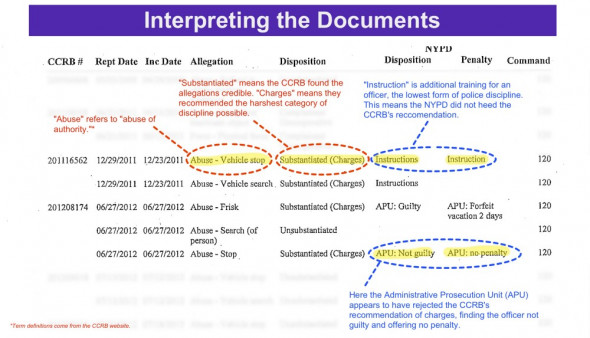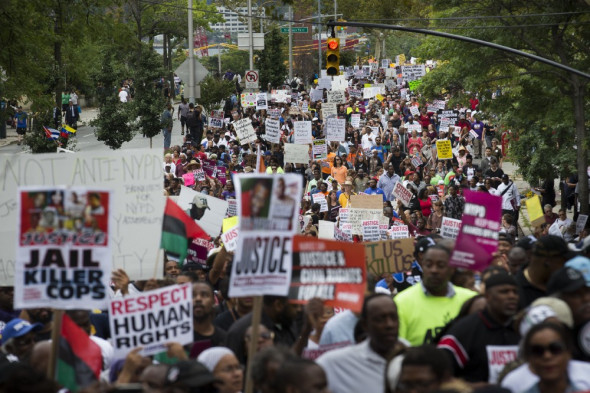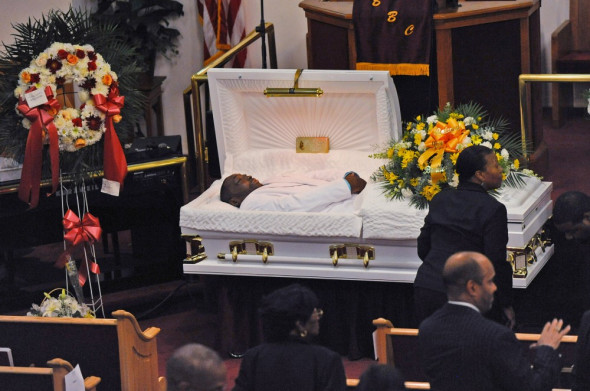Above Photo: Eric Garner All Blood is Red protest NYC by Waging Nonviolence
Note: The New York Times reports that after a quick investigation the employee of the NYC Civilian Complaint Review Board who leaked the documents described below was forced to resign. In addition the CCRB has now confirmed that the documents that were leaked are authentic. The bottom line: the police officer who killed Eric Garner, who had a long history of complaints and prior complaints confirmed by the CCRB, remains on the New York City police force and the employee who leaked the records showing his lengthy prior history has been forced to resign. Do these actions make New York City safer? The police more accountable? Or, do they have the opposite impact? KZ
Official disciplinary records have been hidden from public scrutiny until now.
On July 17, 2014, NYPD Officer Daniel Pantaleo wrapped his arms around Eric Garner’s neck and squeezed. He held tight as his colleagues slammed Garner, 43 years old and asthmatic, to the ground. Garner, who was unarmed at the time, gasped for air, arm outstretched, saying “I can’t breathe” over and over as officers piled on top of him. Then he was silent.
The next day, when the New York Daily News released video of the encounter, Garner had already died from neck and chest compression. His death sparked national protests about police violence against the black community, and his final words, “I can’t breathe,” became a rallying cry for the Black Lives Matter movement. On December 3, 2014, when a grand jury decided not to indict Pantaleo, thousands of people in cities all over the country stormed the streets to chant Garner’s dying words.
Officer Daniel Pantaleo. CREDIT: YouTube/New York Daily News
Pantaleo became a symbol of law enforcement that acts with impunity — especially with respect to white officers interacting violently with black men. Not only had Pantaleo killed a man accused of bootlegging cigarettes, but he’d used a chokehold prohibited by the NYPD to do it.
Now, documents obtained exclusively by ThinkProgress indicate that Pantaleo, who is still employed by the NYPD, had a history of breaking the rules. These records are the subject of an ongoing lawsuit, and the city refuses to release them.
Before he put Garner in the chokehold, the records show, he had seven disciplinary complaints and 14 individual allegations lodged against him. Four of those allegations were substantiated by an independent review board.
Neither Pantaleo nor the NYPD responded to ThinkProgress requests for comment.
A pattern of problematic behavior
Pantaleo’s apparent disciplinary history was sent to ThinkProgress from an anonymous source who said they worked at the New York City Civilian Complaint Review Board (CCRB), an independent agency that receives and investigates complaints against NYPD officers. The source did not disclose their name or identity to ThinkProgress, but four New York City attorneys told ThinkProgress the documents match the appearance of summaries of disciplinary proceedings before the CCRB. Two of these attorneys declined to have their names associated with the verification of the documents, citing fear that they would be associated with the leak.
“It sure looks like a bona fide CCRB document,” said Christopher Dunn, who serves as associate legal director at the New York Civil Liberties Union (NYCLU) and has worked closely with the CCRB for years. He and others were quick to note that the documents could be forgeries, while acknowledging that producing them would be difficult.
The CCRB declined to comment on whether or not the documents were authentic when contacted by ThinkProgress. However, when asked if a CCRB complaint number listed on the documents (CCRB# 201116562) was a real case, representatives confirmed that it was, adding that it had been closed. The CCRB press office would not say if it was attributed to Pantaleo, as the agency does not typically disclose the names of officers attached to cases.
The documents show four of the allegations were substantiated by the CCRB, which recommended disciplinary action against Pantaleo years before he killed Garner. According to the records, the agency had sufficient evidence of an abusive vehicle stop and search by Pantaleo in 2011, which resulted in a two-part complaint. The agency also substantiated allegations about an abusive stop and frisk in 2012, which resulted in another two-part complaint that was reported by DNAinfo in April 2016.
According to the opinion of experts interviewed by ThinkProgress and our own review of CCRB data, this, along with the sheer number of cases, indicates a chronic history of complaints against Pantaleo and would make his disciplinary history with the CCRB among the worst on the force.
The documents indicate that the CCRB pushed for the harshest penalties it has the authority to recommend for all four substantiated allegations: charges that aren’t criminal, but “launch an administrative prosecution in the NYPD Trial Room,” according to the CCRB, and can result in suspension, lost vacation days, or termination. But the NYPD, which is not required to heed the CCRB’s recommendations, imposed the weakest disciplinary action for the vehicular incident: “instruction,” or additional training.
It also diverged from the CCRB’s stance on the 2012 stop and frisk. While the NYPD found Pantaleo guilty of unauthorized frisking, it cleared him of making an abusive stop. Instead of eight forfeited vacation days, per the CCRB’s recommendation, Pantaleo only had to forfeit two.
 CREDIT: Illustration of CCRB document by Jack Jenkins/ThinkProgress
CREDIT: Illustration of CCRB document by Jack Jenkins/ThinkProgress
Jonathan Moore, a civil-rights attorney who represented Garner’s family and four of the Central Park Five, noted that the previous stop-and-frisk case was telling.
“Imagine that. Here’s the disposition of a substantiated charge for making a bad vehicle search and a bad vehicle stop, and the remedy is instruction,” Moore told ThinkProgress. “What happened on July 17th with Eric Garner was a bad stop and frisk.”
The documents also show allegations that Pantaleo refused to seek medical treatment for someone in 2009, hit someone against an inanimate object in 2011, made abusive vehicular stops and searches on two separate occasions in 2012, and used physical force during another incident in 2013.
The documents indicate that the 2009 and 2013 incidents were unsubstantiated by the CCRB, meaning “available evidence is insufficient to determine whether the officer did or did not commit misconduct.” So too were the vehicular stops and searches in 2012. The 2011 case was closed because the complainant was “uncooperative,” which the agency describes as not answering investigator requests for an interview or missing two interviews.
But legal experts say the number of complaints should have raised red flags, even if they weren’t substantiated.
“Regardless of the outcome, if you get three complaints in a year, you’re supposed to be on performance monitoring,” Moore said. “He got three in the course of two months in 2012.”
A record that stands out
Even a conservative reading of the documents indicates Pantaleo had among the worst CCRB disciplinary records on the force two years before his encounter with Garner. Yet the NYPD allowed him to stay on the streets.
When compared with publicly available data posted on the CCRB’s website, the records show that Pantaleo was subject to far more disciplinary allegations and substantiated complaints than the majority of his 36,000 fellow NYPD officers. The CCRB data, which is based on cases closed from 2006 to 2017, has its limitations: it does not appear to control for variables such as age or how long an officer has been on the force. For example, an officer with a decade in uniform may have the same number of complaints as an officer with just a year’s experience: common sense would say the less-experienced officer is the worse offender, but the records would make no distinction between these two hypothetical cases.
Nevertheless, a ThinkProgress analysis of available CCRB data found that only 1,750 current NYPD officers — or around 4.9 percent of the force — have received eight or more complaints, as Pantaleo has. The same data also shows that only 738 officers — about 2 percent — have two or more complaints with substantiated allegations.
It is rare for the CCRB to substantiate complaints at all: Only 5 percent of complaints made to the CCRB were substantiated in 2011, when the agency first recommended charges against Pantaleo. Similarly, only 9 percent of complaints were substantiated in 2012, when the CCRB again recommended charges against him (in the past decade, 2012 was the year with the lowest number of complaints filed).
Complaints older than 3 years are not available for review on the website, and the data does not list the officer’s name.
Pantaleo’s CCRB disciplinary record stops in 2014, when he was put on desk duty in response to Garner’s death. The CCRB case number on the document that appears to reference this incident, when entered into the CCRB’s web-based complaint status lookup, indicates an investigation is ongoing.
“[H]e was an officer with a checkered past.”
“It’s clear he was an officer with a checkered past,” Moore said, referencing the leaked documents. Moore noted that Pantaleo also had three complaints filed in federal court (one was settled, one was dismissed, and one was rejected on summary judgment but remains active on appeal).
The CCRB records don’t elucidate what happened to warrant each of the complaints against Pantaleo.
Anyone can file an initial complaint against an officer in several ways: making one in person at the CCRB office or satellite locations, completing a form on its website, calling its hotline, or sending a written letter. They can also pick up a complaint form at a police station and mail it to the CCRB. To trigger an official investigation, however, complainants have to give an investigator an in-person statement.
According to Cynthia Conti-Cook, a staff attorney at New York’s Legal Aid Society, some people are physically unable to visit the CCRB office, and the agency does its best to accommodate them. But when the CCRB determines that a complainant is “uncooperative,” as it did in a case against Pantaleo, the complainant may have just given up on the CCRB or been scared to go through with the process.
“That’s intimidating for a lot of people,” said Conti-Cook, who belongs to Legal Aid’s Special Litigation Unit.
During its most recent public board meeting in February, the CCRB’s interim executive director, Jonathan Darche, said the agency has “a duty to investigate complaints in an effective and thorough fashion” that takes into account why a complainant was not reachable. “Before an investigator can close a case as ‘complainant unavailable,’ he or she must make a certain minimum number the contact attempts,” he said. Darche also mentioned community feedback that the agency has received about fear of retaliation for pursuing a complaint.
“Some of the issues raised by these groups include the fact that people fear retaliation if they follow through with a complaint and that our complaint process is too complicated and the requirements we have too numerous,” he said. “The staff is committed to working through these issues to attempt to address these concerns. There may not be solutions but we as an agency have an obligation to look and see if we can find answers to these issues.”
As for the investigation process, Conti-Cook also raised concerns about the hiring resources at the CCRB’s disposal, which she learned about several years ago. “They’d been hiring investigators who are fresh out of undergrad, and they were up against police officers in a lot of these interviews who sort of just give them a narrative of the event and then don’t answer follow-up questions and have a union representative present.”
According to the CCRB website, there is a rigorous training process for all investigators. Each investigator is overseen by a manager with a minimum of eight years of investigative experience with another investigative or law enforcement agency.
The CCRB records don’t indicate which investigators were assigned to the apparent cases against Pantaleo, let alone their experience levels. Still, his record should have stood out to the NYPD.
 Demonstrators march to protest the death of Eric Garner in the Staten Island borough of New York. CREDIT: AP Photo/John Minchillo
Demonstrators march to protest the death of Eric Garner in the Staten Island borough of New York. CREDIT: AP Photo/John Minchillo
Transparency vs. privacy for uniformed officers
Pantaleo’s CCRB disciplinary record is part of a court battle between Legal Aid Society and the CCRB, which has refused to disclose his records and the records of other NYPD officers accused of misconduct. That information used to be available to the public, but a policy change has made them largely inaccessible.
According to Conti-Cook, the CCRB had released officers’ complaint histories to attorneys and reporters upon request beginning in October 2013, but abruptly halted the practice in September 2014. The CCRB declined Legal Aid’s request for Pantaleo’s disciplinary record in December 2014, so the latter filed a lawsuit in February 2015. The lawsuit only asked for substantiated CCRB findings on Pantaleo — not a summary of all complaints against him. Within months, State Justice Alice Schlesinger ruled in Legal Aid’s favor, saying Pantaleo’s substantiated records had to be handed over. The city’s lawyers appealed the ruling.
At the center of the dispute is a section of the New York civil rights code that the city’s lawyers say protects certain officer information: Section 50-a. According to the code, “All personnel records used to evaluate performance toward continued employment or promotion, under the control of any police agency or department of the state… shall be considered confidential and not subject to inspection or review without the express written consent of such police officer…”
City lawyers argue that handing over disciplinary records would violate the statute. But civil rights lawyers say that interpretation is erroneous, and doesn’t match up with history. Just as the CCRB released records upon request in the past, the NYPD used to be forthcoming about internal officer activity. For over four decades, it published daily “personnel orders” about goings-on within the department, from promotions to disciplinary actions. The information was posted in precincts and made available to reporters via the deputy commissioner for public information’s office.
The city stopped sharing that information in 2016, saying this longstanding practice was also in violation of 50-a.
Civil rights attorneys, advocacy groups, and journalists view the shift as a crackdown on transparency, despite the fact that Mayor Bill de Blasio campaigned on a platform of police reform.
Justice Department replaces New York team investigating Eric Garner’s death
The criminal investigation may finally be moving forward.
thinkprogress.org
“There is enormous frustration,” the NYCLU’s Dunn said. “As this dispute illustrates, [de Blasio] has not been good on police transparency. Indeed, arguably we are going backwards on police transparency. At this point there is even less information available about… disciplinary practices around police officers than there was before he came into office.”
Mayor de Blasio’s office disputed this claim.
“The mayor has delivered the farthest reaching police and criminal justice reforms of any mayor in the city’s history, including a commitment to equip all patrol officers with body cameras by 2019,” Austin Finan, as mayoral spokesman, told ThinkProgress. “We’ve been unequivocal about the need for greater transparency and urge advocates in favor of greater, lawful transparency to join us in that fight.”
The battle over police transparency could have a widespread impact. Samuel Walker, an emeritus professor at the University of Nebraska’s School of Criminology and Criminal Justice, told ThinkProgress that New York City unofficially wields incredible influence over police departments across the U.S. With the largest police force in the country and a robust local media presence, the NYPD can impact how officers and unions operate elsewhere.
“New York City news becomes national news,” Walker said.
“I don’t think it [the resistance to transparency] comes from the CCRB. I’m convinced it’s coming from the City of New York law department,” Conti-Cook said. “And I think that it’s a huge conflict for the City of New York law department to represent both the NYPD and the thousands of officers a year that are sued and to also represent the CCRB in a case like this, where the CCRB’s mission — and in every way its public interest — is supportive of transparency.” The New York City Law Department did not respond to a request for comment.
“[A]rguably we are going backwards on police transparency.”
Cook said that Legal Aid filed two other lawsuits against the CCRB, demanding disciplinary information for two other NYPD officers. It filed a fourth lawsuit in December 2016 against the NYPD to publicize documentation of all disciplinary actions from 2011 onward. Conti-Cook said oral arguments for the NYPD lawsuit are scheduled for this month. If Legal Aid wins that case, it could reverse the NYPD’s new restrictive interpretation of 50-a. Legal Aid hasn’t heard any indication that the NYPD intends to settle its lawsuit.
“[Police] are public officials who have powers that no other occupational group in this country has. They have the power to detain people, arrest them, to use physical force, and use deadly force,” Walker said, adding that disciplinary action against lawyers, health care professionals, and even dentists is shared with the public. “It is critical that we understand what they do and are they using those powers properly and lawfully.”
In January, NYPD Deputy Commissioner Kevin Richardson told the New York Times, “Going forward and working collectively with the Law Department, we will figure out the parameters of how we can regularly disclose the information as regularly as possible, while 50-a exists.”
Mayor de Blasio’s office, for their part, told ThinkProgress they will “continue to advocate for a change in the law.”
 Eric Garner’s body lies in a casket during his funeral. CREDIT: AP Photo/New York Daily News, Julia Xanthos
Eric Garner’s body lies in a casket during his funeral. CREDIT: AP Photo/New York Daily News, Julia Xanthos
Officer Pantaleo’s future
Meanwhile, Pantaleo’s fate currently rests in the federal government’s hands.
In December 2015, then-Police Commissioner Bill Bratton announced that the NYPD had completed its internal investigation of the Garner incident, but would not take disciplinary action until the Justice Department completed its own probe. As of January 19, the Justice Department was still investigating, but Attorney General Jeff Sessions could pull the plug. He has been a vocal opponent of federal investigations into local police departments. However, the Hill reported that Sessions informed civil rights activists on March 7 that the investigation will proceed.
As of September 2016, Pantaleo was on desk duty without a firearm. Awaiting his fate, he received a raise last year. His 2016 salary was $119,996 — a 14 percent increase from what he was making when he killed Garner.





